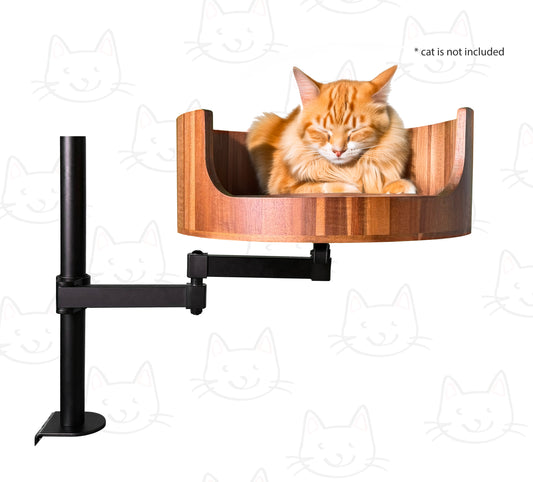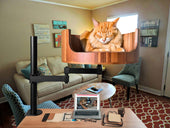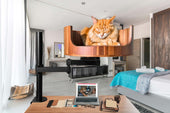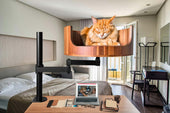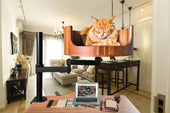
Cats Tail Is Wagging: Understanding Feline Behavior
Share
If you've ever noticed your cat's tail wagging, you may have wondered what it means. Contrary to popular belief, it's not just a sign of a happy cat; there's much more to feline tail behavior than meets the eye. In this article, we will dive into the world of cats' tails, exploring the various meanings behind their movements and how they can help us better understand our feline friends.
From flicking tails to bushy tails, every movement serves a purpose in cats' communication. By decoding these signals, we can decipher their mood, intentions, and even potential warning signs. By understanding the nuances of cats' tail behavior, we can develop a deeper connection with our pets and provide them with the care and attention they need. So, the next time you see your cat's tail wagging, you'll know that there's much more going on beneath the surface.
1. A cat's tail wagging can indicate their mood or intentions, similar to a dog's tail wagging.
2. Understanding the subtleties of a cat's tail movements can help cat owners better communicate and bond with their pets.
3. Tail twitching, slow swishing, and rapid thrashing are just a few examples of how a cat's tail movement can convey different messages.
4. Paying attention to a cat's tail can provide valuable insight into their emotional state, allowing owners to respond appropriately to their needs.
5. By interpreting their cat's tail wagging, owners can deepen their connection with their feline companion and strengthen their relationship.
## Importance of Understanding Feline Behavior
Understanding feline behavior, including tail wagging, is crucial for cat owners to develop a strong bond with their pets. Cats communicate through various body language cues, and their tails play a significant role in expressing their emotions and intentions. By learning how to interpret a cat's tail movements, owners can better understand their pets' feelings and needs, leading to improved interactions and overall welfare for the cat.
## Common Tail Wagging Behaviors
There are different types of tail wagging behaviors in cats, each conveying a specific message. For example, a slow and relaxed tail wag typically indicates that the cat is content and happy. On the other hand, a fast and agitated tail wag may signify that the cat is feeling threatened or stressed. Understanding these variations in tail movements can help owners respond appropriately to their cat's emotional state and provide the necessary support or intervention.
## Signals of Aggression or Playfulness
In some cases, a cat's tail wagging may be a sign of aggression or playfulness. Cats may twitch their tails rapidly when they are in a playful mood, often accompanied by other playful behaviors such as pouncing or chasing. On the other hand, a cat with a puffed-up tail and aggressive tail movements may be preparing to attack or defend itself. By recognizing these signals, owners can prevent potential conflicts and ensure a safe environment for their cat.
## Tail Positions and Their Meanings
In addition to tail wagging, the position of a cat's tail can also provide valuable insights into their mood and intentions. For instance, a raised tail generally indicates that the cat is feeling confident and in control of its surroundings. Conversely, a lowered or tucked tail may signal fear or submission. By observing the position of their cat's tail in different situations, owners can gain a deeper understanding of their pet's emotional state and respond accordingly to provide comfort and support.
Desk Cat Nest FAQ
Why is my cat's tail wagging?
There are several reasons why a cat's tail might be wagging. It could be a sign of excitement, agitation, or even aggression. It's essential to observe your cat's body language and behavior to determine the reason behind the tail wagging.
Will the Desk Cat Nest help with my cat's tail wagging issue?
The Desk Cat Nest provides a cozy and secure space for your cat to relax and destress, which can help reduce tail wagging caused by anxiety or agitation. However, if your cat's tail wagging is a result of an underlying medical issue, it's crucial to consult with a veterinarian.
How can I introduce my cat to the Desk Cat Nest?
It's recommended to place the Desk Cat Nest in a quiet and comfortable area where your cat likes to spend time. You can entice your cat with treats or toys to explore the nest. You can also add familiar bedding or clothing with your scent to make it more inviting for your cat.
Is the Desk Cat Nest suitable for all cat breeds?
Yes, the Desk Cat Nest is designed to accommodate cats of all breeds and sizes. The plush cushion provides a soft and cozy space for cats to relax and curl up comfortably.
How do I clean the Desk Cat Nest?
The Desk Cat Nest comes with a removable and washable cushion for easy cleaning. Simply unzip the cushion cover and machine wash it on a gentle cycle with mild detergent. Air dry the cushion thoroughly before placing it back in the nest.
In conclusion, the Desk Cat Bed is a valuable choice for cat owners seeking to address the issue of their cat's tail wagging. This unique bed provides a cozy and comfortable environment for cats to relax and unwind, reducing stress and anxiety that can contribute to excessive tail wagging. The elevated design also helps cats feel secure and in control of their surroundings, promoting a sense of calm and contentment. With its plush cushioning and convenient size, the Desk Cat Bed is a must-have for any cat owner looking to improve their feline's well-being and overall happiness.

